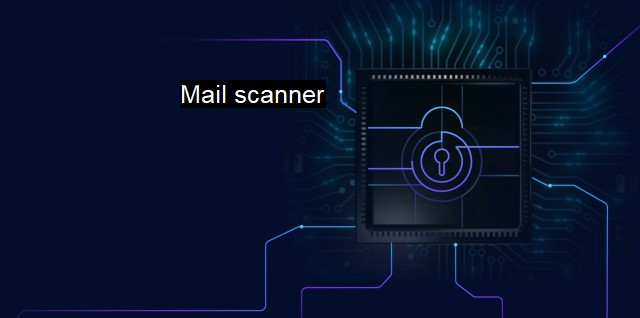What is Mail scanner?
Secure Your Inbox with Mail Scanners: Advanced Email Security Techniques to Block Malware, Spam, and Phishing Attempts
Mail scanner, often referred to as mail antivirus scanner, is a component of cybersecurity technology focused on screening and filtering data flowing to and out from email clients and servers. Email is one function of modern digital communication that is often targeted due to its widespread use by both businesses and individuals, making it a stark point of vulnerability. Mail scanner operates to secure these communication channels, drastically reducing potential unwanted cybersecurity incidents.In understanding a mail scanner, it is crucial to throw light on the rationale for its deployment within cybersecurity systems. A common way hackers and other cybercriminals distribute malware or malicious software is via email. Cybercriminals typically hide these system-disrupting wares within seemingly innocuous email attachments. The unsuspecting user, upon opening the email or its attachment, unwittingly activates the malware, which then goes on to cause diverse degrees of damage. Some lead to data compromise, allowing unauthorized persons to access sensitive information, while others may completely shut down a computer system or network.
Mail scanner acts as a type of safeguard, scrutinizing all incoming email data for any potential threats. The scanner applies various antivirus checks on email items and their embedded components, such as attached files or inline images. Once such a check is complete, the scanner then decides on an action in real-time based on its findings. If malicious software or data is discovered, the infected email is usually deleted or quarantined.
A mail scanner is also efficient in mitigating threats from spam email, which could easily inundate one's inbox, lessening productivity and sometimes acting as a delivery mechanism for malicious software. Many modern mail scanner solutions are equipped with anti-spam detection. They apply filters that recognize spam characteristics, such as a suspicious address source or misleading subject line, and these emails are typically blocked entirely or diverted into the junk folder.
a mail scanner can identify phishing attempts, another cyber-attack mode cybercriminals commonly employ. Here, impersonated emails appearing as legitimate communications are sent to trick recipients into sharing personal data like credit card details or login credentials. With phishing attempts growing increasingly sophisticated, the role of the mail scanner becomes more paramount. It hunts for such threats, using complex algorithms to define if an email is a phishing attempt, even distinguishing this through tactics like minute alterations in the domain name that others could easily overlook.
Adopting a mail scanner as part of a cybersecurity strategy is thus vital. Its application ranges across end-user devices like smartphones and personal computers to workstations in large corporate environments and even enterprise-scale mail servers. This wide applicability stems from the importance of secure email communication in our digitally-dependent world.
a robust cybersecurity system will employ a mail scanner as an essential part of a multi-layered defense strategy, often styled the Defense-in-Depth approach. Given that cybersecurity threats persistently evolve, the scanner itself is continuously fine-tuned to keep up with the changing threat landscape, equipped with updates to deal with new and incoming threats on a real-time basis.
When paired with user education on how to recognize potential threats, a mail scanner is an effective tool designed to protect sensitive data, maintain system integrity, and drastically mitigate cyber threats. Thus, the robust capabilities of a mail scanner showcase its expert role in a comprehensive cybersecurity arsenal, promoting safer and more secure digital communications.
In a domain continually impacted by sophisticated cyber threats and increasingly reliant on secure communication channels, the mail scanner stands as an integral part of the digital world's backbone, enabling the fluid and secure use of email communication for all.

Mail scanner FAQs
What is a mail scanner?
A mail scanner is a cybersecurity tool that scans incoming and outgoing emails for viruses, malware, and other threats to ensure that the email system is secure.How does a mail scanner work?
A mail scanner works by analyzing the content of emails and attachments for suspicious patterns and signatures. It then compares the content with known virus and malware signatures to determine if the email contains a threat. If a threat is detected, the mail scanner will either quarantine or delete the email, depending on the configuration of the system.Why is a mail scanner important for cybersecurity?
A mail scanner is important for cybersecurity because email is one of the most common attack vectors for viruses, malware, and other threats. By scanning incoming and outgoing emails, a mail scanner can prevent these threats from entering or leaving the email system, thus protecting the network and the devices connected to it.What features should I look for in a mail scanner?
When choosing a mail scanner, it is important to look for features such as real-time scanning, automatic updates of virus/malware definitions, attachment filtering, and customizable policies for quarantining or blocking emails. It is also important to consider the scalability of the system and the level of technical support provided by the vendor.| | A | | | B | | | C | | | D | | | E | | | F | | | G | | | H | | | I | | | J | | | K | | | L | | | M | |
| | N | | | O | | | P | | | Q | | | R | | | S | | | T | | | U | | | V | | | W | | | X | | | Y | | | Z | |
| | 1 | | | 2 | | | 3 | | | 4 | | | 7 | | | 8 | | |||||||